Last year gave us three giants of Post-Impressionism. The Royal Academy promised to unveil the real Van Gogh by showing us the man of letters; Tate Modern delivered a sumptuous survey of Gauguin; and a significantly smaller but nonetheless intelligent and illuminating display at the Courtauld Gallery homed in on just one series of paintings in Cézanne’s oeuvre - the ambitious, masterly and compositionally complex The Card Players.
So was 2010 the year of the blockbuster, or the moreishly bite-sized? OK, it's difficult - and a bit pointless - to make comparisons between exhibitions with such widely differing aims. The Real Van Gogh: The Artist and His Letters (23 January to 18 April, 2010) was comparatively low key compared to Gauguin: Maker of Myth (30 September to 16 January, 2011) since the Royal Academy’s exhibition confined itself to those paintings described in detail - or beautifully sketched - by the Dutch artist in his letters. The resulting survey contained few familiar masterpieces – and just one lesser-known self-portrait, ear intact - which means, inarguably, that the blockbuster crown must go to Gauguin. Tate Modern’s extensive exhibition placed the familiar late canvases, which draw us into the artist’s exotic world of mystic symbolism, alongside his little-known woodcuts and sculptures.
But one thing rankled: the thematic hang. Such dizzying leaps in chronology give little satisfaction to those of us who still cling to the notion that a historical overview can reveal important things about an artist, and Tate’s curators continue to be seduced by Themes (linearity so gets a bad press). Moreover, surely Gauguin is an artist who, more than any other, makes one think of Tony Hancock in The Rebel, so an exhibition which focused on the self-mythologising of this master among self-mythologisers was bound to tap into some latent comic vein, at least for this viewer. Still, the exhibition proved a huge critical hit, and if you haven’t yet seen what all the fuss is about, the show will still be pulling in the crowds for another two weeks.
 Whereas Gauguin’s earlier paintings far outshine, in my view, his later ones, both Van Gogh and Cézanne reach their brilliance with increasing maturity (in Van Gogh's case, this was early enough, since he had a very short career). This is exactly why the Courtauld Gallery’s wonderful Cézanne exhibition hit the spot. Cézanne’s Card Players (21 October to 16 January, 2011; pictured right, The Card Players 1890-2) was the type of refreshingly small, expertly focused exhibition which proves that greater pleasures don‘t have to come with an exhaustive surfeit of offerings. Concentrating on just one aspect of the artist’s output, this slim, distilled display provided much insight into Cézanne’s practice as a whole, and in so doing delighted the mind as well as the eye.
Whereas Gauguin’s earlier paintings far outshine, in my view, his later ones, both Van Gogh and Cézanne reach their brilliance with increasing maturity (in Van Gogh's case, this was early enough, since he had a very short career). This is exactly why the Courtauld Gallery’s wonderful Cézanne exhibition hit the spot. Cézanne’s Card Players (21 October to 16 January, 2011; pictured right, The Card Players 1890-2) was the type of refreshingly small, expertly focused exhibition which proves that greater pleasures don‘t have to come with an exhaustive surfeit of offerings. Concentrating on just one aspect of the artist’s output, this slim, distilled display provided much insight into Cézanne’s practice as a whole, and in so doing delighted the mind as well as the eye.
The year also saw two Picasso exhibitions, one in a major public space, the other more than holding its own in a commercial gallery. These proved once again that size isn‘t everything. Tate Liverpool’s Picasso: Peace and Freedom (21 May to 30 August, 2010) overplayed Picasso’s political activism to a degree that bordered on the risible: a 1965 painting of a cat and a lobster was a comment on the Cuban Missile crisis; the artist’s haunting self-portrait as a Rembrandt-esque musketeer, painted just a year before his death, was an anti-war rant; and his reinterpretation of Manet’s Le déjeuner sur l’herbe was a salute to the burgeoning women’s movement.
Indeed, the curators of this agenda-heavy exhibition were so taken with their “revaluation” of the artist as a peace-loving activist/feminist sympathiser that the works were all myopically filtered through a lens that wasn't so much reductive as terribly warped. In addition, Tate Liverpool’s selection - vast as the exhibition was – did little to show off the radical genius of Picasso at his provocative and engaging best.
 By contrast, the Gagosian Gallery’s superb Picasso: The Mediterranean Years 1945-62 (4 June to 28 August, 2010, pictured left: Musicien assis, 1956), curated by the artist’s friend and biographer John Richardson, surpassed all expectations and presented a museum-standard show in concentrated form. Beautifully displayed and atmospherically lit, the exhibition showed us an artist who was both exuberantly playful and unceasingly inventive - exactly what Tate Liverpool had failed to do.
By contrast, the Gagosian Gallery’s superb Picasso: The Mediterranean Years 1945-62 (4 June to 28 August, 2010, pictured left: Musicien assis, 1956), curated by the artist’s friend and biographer John Richardson, surpassed all expectations and presented a museum-standard show in concentrated form. Beautifully displayed and atmospherically lit, the exhibition showed us an artist who was both exuberantly playful and unceasingly inventive - exactly what Tate Liverpool had failed to do.
Meanwhile, a less dazzling master but an abidingly influential artist all the same, in the tradition of English painters going back to Blake and Samuel Palmer, was given a very welcome retrospective at Dulwich Picture Gallery. Paul Nash: The Elements (10 February to 9 May, 2010) presented a seductive yet unsettling survey of a painter whose work is embedded in the tradition of the landscape as a mythic and mystical entity. It was the painting exhibition of the year, just about eclipsing another great figurative painter, the American Alice Neel. Neel’s brittle, acutely observed portraits of friends, family, New York’s literati and the city's art-scene hipsters triumphed at the Whitechapel Gallery (Alice Neel: Painted Truths, 8 July to 17 September, 2010).
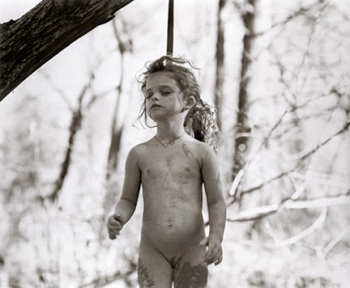 As for photography, we were spoilt for choice. There were shows ranging from retrospectives of glamorous celebrity portraitists (Irving Penn, National Portrait Gallery, 18 February to 6 June, 2010) to all but forgotten innovators in the medium’s history (Camille Silvy: Photographer of Modern Life 1834-1910, National Portrait Gallery, 6 June to 24 October, 2010) and groundbreaking artists who radically transformed the way we view the world (Eadweard Muybridge, Tate Britain, 8 September to 16 January, 2011). But my choice for photography exhibition of the year has to go to Sally Mann, a contemporary photographer who uses 19th-century techniques for capturing both the living and the dead, for her unforgettable exhibition at the Photographers’ Gallery (Sally Mann: The Family and the Land, 17 June to 18 September, 2010; pictured above right: from the series Immediate Family, 1990).
As for photography, we were spoilt for choice. There were shows ranging from retrospectives of glamorous celebrity portraitists (Irving Penn, National Portrait Gallery, 18 February to 6 June, 2010) to all but forgotten innovators in the medium’s history (Camille Silvy: Photographer of Modern Life 1834-1910, National Portrait Gallery, 6 June to 24 October, 2010) and groundbreaking artists who radically transformed the way we view the world (Eadweard Muybridge, Tate Britain, 8 September to 16 January, 2011). But my choice for photography exhibition of the year has to go to Sally Mann, a contemporary photographer who uses 19th-century techniques for capturing both the living and the dead, for her unforgettable exhibition at the Photographers’ Gallery (Sally Mann: The Family and the Land, 17 June to 18 September, 2010; pictured above right: from the series Immediate Family, 1990).
Now, where big did manage to impress was an exhibition with a title almost as expansive as the show. Tate Modern's hugely ambitious Van Doesburg and the International Avant-Garde: Constructing a New World (4 February to 16 May, 2010) told us a lot we didn't know about the founding member of the De Stiljl movement and showed us even more. The primary-coloured square and the soaring diagonal became radical once more as we learned how two grown artists could fall out over the permissable direction of a line (Mondrian held firm on the horizontal and the vertical, while Van Doesburg was unbending over the use of the diagonal, and the two artists refused to have anything to do with each other for six years).
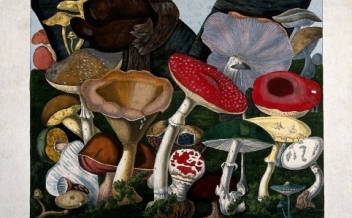 And finally, one exhibition that really deserves to be remembered as a highlight of the year but isn’t strictly an art exhibition is High Society (pictured left: an 1827 lithograph of mushrooms by A Carnillon), an exploration of how different societies at different times have viewed the taking of mind-altering substances, for leisure, for therapy, or for ritual (Wellcome Collection, 11 November to 27 February, 2011). The Wellcome Collection is a venue that marries science, art and culture better than anyone else, so if you want to fill yourself with stimulating facts after your Christmas bloat, you could do worse than head to Euston.
And finally, one exhibition that really deserves to be remembered as a highlight of the year but isn’t strictly an art exhibition is High Society (pictured left: an 1827 lithograph of mushrooms by A Carnillon), an exploration of how different societies at different times have viewed the taking of mind-altering substances, for leisure, for therapy, or for ritual (Wellcome Collection, 11 November to 27 February, 2011). The Wellcome Collection is a venue that marries science, art and culture better than anyone else, so if you want to fill yourself with stimulating facts after your Christmas bloat, you could do worse than head to Euston.
Forthcoming Highlights
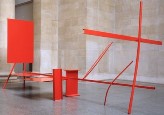 British Modern Sculpture Royal Academy, 22 January to 7 April, 2011
British Modern Sculpture Royal Academy, 22 January to 7 April, 2011
An overview of British sculpture of the 20th century, a show that promises a unique view of its development, with a look at sculpture outside the British Isles as well as within it (pictured right: Anthony Caro, Early One Morning, 1962).
Watercolour Tate Britain, 16 February to 21 August, 2011
A history of watercolour painting, from its emergence in illuminated manuscripts of the Middle Ages through to the present day.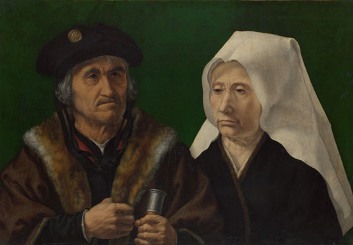 Jan Gossaert’s Renaissance National Gallery, 23 February to 30 May, 2011
Jan Gossaert’s Renaissance National Gallery, 23 February to 30 May, 2011
A survey of the 16th-century Netherlandish painter whose sensual nudes evoke the sheen of marble and whose illusionistic portraits play intriguing spatial games (pictured left: An Elderly Couple, c 1520).
British Art Show: In the Days of the Comet Hayward Gallery, 16 February to 17 April, 2011
Taking the temperature of British art now, the British Art Show travels from Nottingham to London on its tour around the country.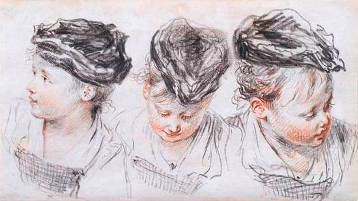 Watteau’s Drawings: Virtuoso and Delight Royal Academy, 11 March to 5 June, 2011
Watteau’s Drawings: Virtuoso and Delight Royal Academy, 11 March to 5 June, 2011
This exhibition presents over 80 exquisite works on paper by the early-18th-century French artist, inventor of the fêtes galantes (pictured right: Three Studies of a Girl Wearing a Hat, c 1716).
The Cult of Beauty: The Aesthetic Movement 1860-1900 Victoria & Albert Museum, 2 April to 17 July, 2011
Whistler, Wilde, Morris, Rossetti – an exhibition which explores the Aesthetic Movement through a range of personalities and art forms.
Joan Miró: The Ladder of Escape Tate Modern, 14 April to 11 September, 2011
One doesn’t often associate Miró with politics, but the Spanish Surrealist lived in politically turbulant times and this exhibition explores his engagement with Catalonia.
René Magritte: The Pleasure Principle Tate Liverpool, 24 June to 16 October, 2011
Another Surrealist adventure for the Tate: the Belgian painter is shown as an artist whose visual language inspired Pop and conceptual art.  Afghanistan: Crossroads of the Ancient World British Museum, 3 March to 3 July, 2011
Afghanistan: Crossroads of the Ancient World British Museum, 3 March to 3 July, 2011
Over 200 treasures, many from the National Museum of Afghanistan in Kabul, which were feared lost after decades of war (pictured left: Gold crown from Tillye Tepe, 1st century AD).
Tracey Emin Hayward Gallery, 18 May to 29 August, 2011
An extensive retrospective of the artist you either love or hate.
Toulouse-Lautrec and Jane Avril: Beyond the Moulin-Rouge Courtauld Gallery, 16 June to 18 September, 2011
An exhibition that explores the collaboration between Toulouse-Lautrec and his muse, the celebrated cabaret singer Jane Avril, immortalised in the French artist’s iconic posters.
Treasures of Heaven British Musuem, 23 June to 9 October, 2011
Saints, relics and images of devotion in medieval England, bringing together over 150 sacred objects.
Post-Modernism: Style and Subversion Victoria & Albert Museum, 24 September to 8 January, 2012
What does Post-Modernism mean, and where did it come from? Featuring design, architecture, art and music, this exhibition aims to provides the answers. 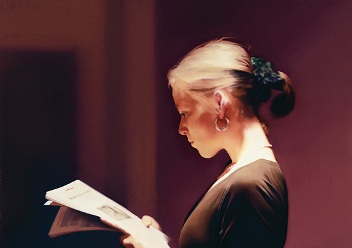 Gerhard Richter: Panorama Tate Modern, 6 October to 8 January, 2012
Gerhard Richter: Panorama Tate Modern, 6 October to 8 January, 2012
A major chronological retrospective of this important German artist which begins with his photorealist paintings and ends with a painting based on an image of the 9/11 attack (pictured right: Reader, 1994).
Leonardo da Vinci: Painter at the Court of Milan National Gallery, 9 November to 5 February, 2012
The most complete display of the Renaissance artist’s rare surviving paintings ever held, and the first exhibition dedicated to his aims and techniques as a painter.
Not an exhaustive list, so do dip into our Arts Calendar for more art happenings.









![SEX MONEY RACE RELIGION [2016] by Gilbert and George. Installation shot of Gilbert & George 21ST CENTURY PICTURES Hayward Gallery](/sites/default/files/styles/thumbnail_125_x_125_/public/mastimages/Gilbert%20%26%20George_%2021ST%20CENTURY%20PICTURES.%20SEX%20MONEY%20RACE%20RELIGION%20%5B2016%5D.%20Photo_%20Mark%20Blower.%20Courtesy%20of%20the%20Gilbert%20%26%20George%20and%20the%20Hayward%20Gallery._0.jpg?itok=3oW-Y84i)





Add comment